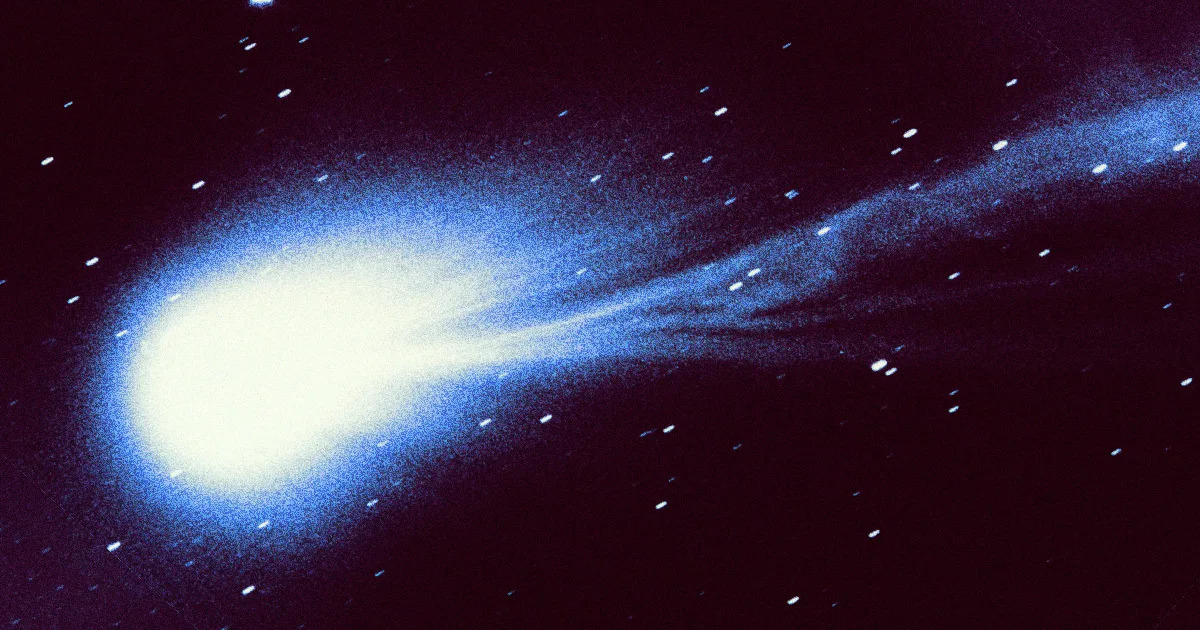Noor Al-Sibai
Thu, December 7, 2023

Middle Path
It's been nearly 40 years since Halley's comet last flew by Earth — and very soon, it will be headed back our way.
As Universe Today reports, this coming Sunday, December 9, the famed comet will reach its furthest point from the Sun. Known as its "aphelion," this is essentially the middle point in Halley's long elliptical orbit through our Solar System.
Named for English astronomer Edmond Halley, who discovered the famed comet and several others in the 18th century, Halley's comet hasn't visible in the night sky since hair metal was all the rage back in 1986.
As exciting as this date is for skywatchers who are waiting for generations to see this gorgeous fireball to streak through Earthly skies — or since 2003, when the European Southern Observatory's Very Large Telescope captured the grainiest of images of the comet as it cruised through the outer edges of our Solar System — they'll still have to wait for quite a while considering that it won't be back around these parts until 2061.
If you're hoping for another telescopic glance of Halley's comet at its furthest, though, you're unfortunately out of luck.
Although both the Hubble and the James Webb space telescopes would certainly be powerful enough to capture images of the comet as it makes its about-face near Jupiter, a NASA spokesperson told Universe Today that there's nothing on either instrument's schedule indicating plans to check it out now or in the future.
Consolation Prize
While we won't get any glimpses of Halley's comet itself for another few decades, we are able to see remnants of it on Earth in the form of the Eta Aquariids meteor shower.
Every year between late April and early May, our planet passes through debris from the tail of Halley's comet, some of which can leave trails that last for a few seconds or even minutes. While this remnant of the famous fireball is most spectacular in the Southern Hemisphere, those of us up here in the Northern half of the globe aren't completely out of luck — we can see 10 to 20 meteors per hour in the pre-dawn hours of its predicted peak on May 5, 2024.
If you're looking for a skywatching fix before the end of the year, the peak of the Geminids meteor shower is slated for December 13 and 14. In an interview with Space.com, NASA meteor expert Bill Cooke said the viewing conditions for it this year are supposed to be exceptional.
More on star stuff: Scientists Discover Star System So Perfect It Seems Like Art
A Gigantic Hole Just Opened Up in the Sun
Victor Tangermann
Thu, December 7, 2023

Solar Hole
A massive hole opened up in the Sun's atmosphere over the weekend, measuring more than 60 times the diameter of the Earth across at its peak.
Coronal holes like this one, imaged by NASA's Solar Dynamics Observatory, occur when the Sun's magnetic field suddenly allows a huge stream of the star's upper atmosphere to pour out in the form of solar wind.
Over a short period of time, these highly energized particles can eventually make their way to us and — if powerful enough — wreak havoc on satellites in the Earth's orbit. In rare instances, they can even mess with the electrical grid back on the ground.
Fortunately, in the case of the latest hole, scientists aren't expecting any major disruptions earlier this week beyond minor to moderate geomagnetic storms, as well as the associated auroras borealis in the night sky, according to SpaceWeather.com.
Weather Men
The appearance of the hole in and of itself isn't entirely unexpected. The Sun will soon reach the peak of its 11-year cycle known as the solar maximum, ushering in a particularly turbulent period of activity.
This activity ranges from simple solar flares to massive outbursts of solar wind called coronal mass ejections.
Coronal holes are only visible in ultraviolet wavelengths, appearing as dark patches of relatively cool particles in our observations. They're less likely to actually fling solar wind outwards as they're simply an opening, allowing for these photons and electrons to escape.
The last time scientists spotted a large coronal hole was in March, causing powerful streams of solar wind to hit the Earth's atmosphere.
Scientists have found that the Sun's solar activity is already stronger than expected this time, meaning that we'll likely see more awe-inspiring events there in the near future.
More on the Sun: Professor Warns That the Sun Is Angry and It Could Knock Out the Internet
No comments:
Post a Comment